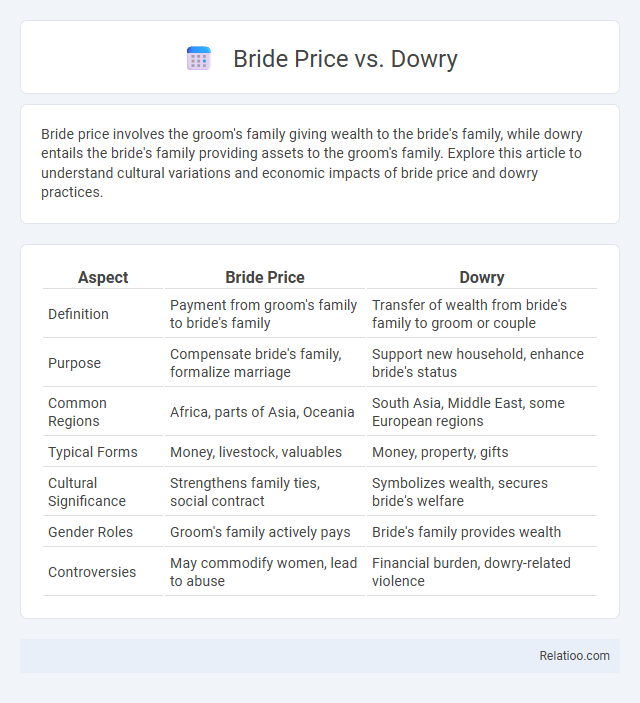Bride price involves the groom's family giving wealth to the bride's family, while dowry entails the bride's family providing assets to the groom's family. Explore this article to understand cultural variations and economic impacts of bride price and dowry practices.
Table of Comparison
| Aspect | Bride Price | Dowry |
|---|---|---|
| Definition | Payment from groom's family to bride's family | Transfer of wealth from bride's family to groom or couple |
| Purpose | Compensate bride's family, formalize marriage | Support new household, enhance bride's status |
| Common Regions | Africa, parts of Asia, Oceania | South Asia, Middle East, some European regions |
| Typical Forms | Money, livestock, valuables | Money, property, gifts |
| Cultural Significance | Strengthens family ties, social contract | Symbolizes wealth, secures bride's welfare |
| Gender Roles | Groom's family actively pays | Bride's family provides wealth |
| Controversies | May commodify women, lead to abuse | Financial burden, dowry-related violence |
Understanding Bride Price and Dowry: Key Definitions
Bride price refers to the payment made by the groom or his family to the bride's family as a cultural or traditional exchange, often symbolizing compensation for the bride's upbringing. Dowry involves the transfer of wealth, property, or gifts from the bride's family to the groom or the newlyweds, generally intended to support the couple's new household. Understanding the distinctions between bride price and dowry is crucial for recognizing their different social, economic, and cultural implications in various societies.
Historical Origins of Bride Price and Dowry
Bride price, historically rooted in patrilineal societies, involved the groom's family providing wealth or livestock to the bride's family as compensation for the loss of their daughter's labor and fertility. Dowry originated mainly in matrilineal or agrarian cultures, where the bride's family transferred property or wealth to the groom's family or newlywed couple to support the establishment of their household. Understanding these distinct origins clarifies how your cultural customs around marriage payments reflect deeply ingrained social and economic structures.
Cultural Contexts: Where Are Bride Price and Dowry Practiced?
Bride price is commonly practiced in African, South Asian, and some Pacific Island cultures, where the groom or his family provides wealth or goods to the bride's family as a symbol of respect and union. Dowry, conversely, is prevalent in South Asia, parts of the Middle East, and some European regions, involving the bride's family transferring wealth or gifts to the groom's family or the newlywed couple to support the marriage. Your understanding of these cultural customs highlights the varying social and economic roles these practices play in sustaining family alliances and traditions across different societies.
Economic Implications: Financial Impact on Families
Bride price involves the groom's family transferring wealth to the bride's family, which can create significant economic pressure on the groom's relatives and reinforce wealth disparities between communities. Dowry requires the bride's family to provide assets or money to the groom's side, often burdening the bride's family financially and influencing household wealth allocation. Understanding these practices' economic implications helps you assess their impact on family finances, inheritance patterns, and broader social stability.
Gender Roles and Social Expectations
Bride price, dowry, and bride service each reflect deeply ingrained gender roles and social expectations within their respective cultures. Bride price often reinforces patriarchal values by framing women as economic assets transferred between families, emphasizing male authority and control. Dowry systems can simultaneously burden women's families while reinforcing female subservience through expectations of marriage as an economic transaction, shaping social norms around gender and family honor.
Legal Frameworks Governing Bride Price and Dowry
Legal frameworks governing bride price and dowry vary significantly across jurisdictions, reflecting cultural norms and human rights considerations. Many countries regulate or prohibit excessive bride price payments to prevent exploitation and ensure gender equality, while dowry laws often aim to protect women from financial abuse and dowry-related violence. Understanding these legal distinctions helps you navigate cultural practices within the boundaries of local laws effectively.
Contemporary Trends and Shifts in Practice
Contemporary trends reveal a decline in traditional bride price and dowry practices, with urbanization and globalization promoting alternative marriage customs emphasizing partnership and equality. Research indicates a shift towards symbolic or token bride price payments, reflecting changing socio-economic values and gender dynamics in societies. Studies also highlight increased legal reforms and advocacy efforts aimed at mitigating financial burdens and addressing human rights concerns linked to these customary exchanges.
Social Consequences: Empowerment or Oppression?
Bride price, dowry, and bride service significantly shape social dynamics by either empowering or oppressing individuals within marriage customs. Bride price can enhance the groom's family's social status but may commodify the bride, potentially limiting her agency and reinforcing patriarchal norms. Dowry often burdens the bride's family financially, risking exploitation and violence, while bride service may empower the bride through mutual labor yet also perpetuate gender inequalities depending on cultural context; your understanding of these practices is crucial to addressing their social consequences effectively.
Case Studies: Examples from Different Countries
Case studies reveal distinct cultural practices regarding bride price and dowry across countries: in Nigeria, the bride price symbolizes respect and union, involving negotiations and gifts from the groom's family to the bride's family. In India, dowry systems often entail the bride's family providing significant wealth, property, or gifts to the groom's family, sometimes leading to social challenges. Meanwhile, pastoral communities in Ethiopia emphasize bride price as a crucial social contract, reinforcing family alliances through livestock or cash payments.
Rethinking Tradition: Toward Equitable Practices
Rethinking tradition requires examining the cultural significance and economic impact of bride price, dowry, and bridal gifts to promote equitable practices. Your efforts to balance respect for heritage with gender equality can transform these customs into exchanges that empower all parties and reduce financial burdens. Emphasizing mutual consent and fair negotiation fosters a more just and inclusive approach to marriage rituals worldwide.

Infographic: Bride Price vs Dowry
 relatioo.com
relatioo.com